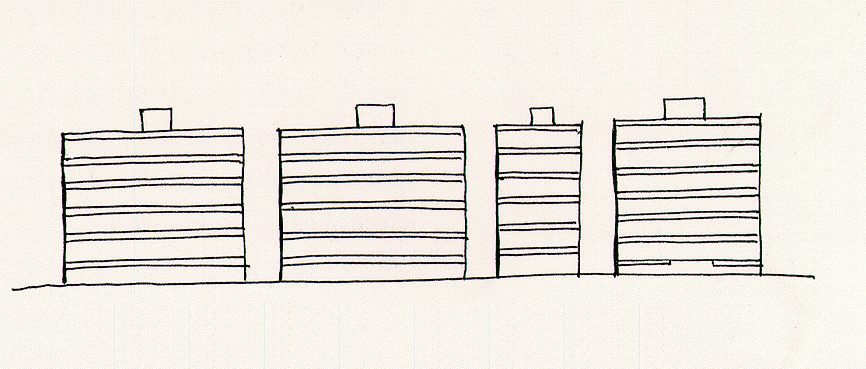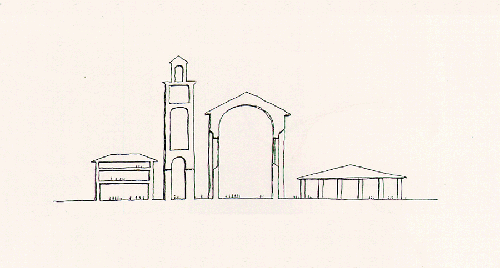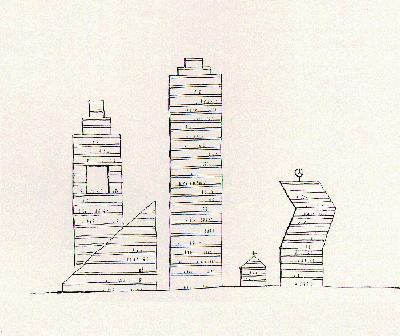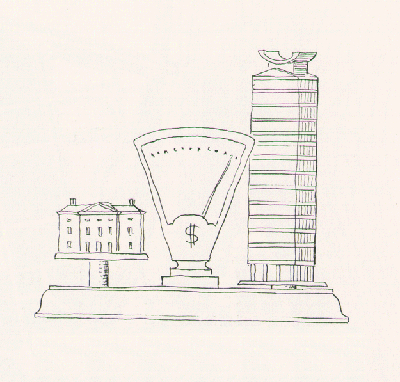The godfather of New Urbanism offers his perspective on the future of cities: The most beautiful cities which survive in the world today have all been conceived with buildings of between two and five floors -- the era of the utilitarian skyscraper is at an end.
Introduction

"Léon Krier may be best known ... as the intellectual godfather of the New Urbanism movement in America, a campaign to rescue the landscape, townscape and civic life of our nation from the failed experiment of a drive-in utopia.
Krier [is] a Luxemburgois who lived in London for twenty years and now makes his home in southern France. He brings an exhilarating clarity to issues of place-making and architecture that have been otherwise subject to a remorseless obscurantism by a colorful cast of self-promoting avant-gardist charlatans ranging from Le Corbusier in the 1920s to Peter Eisenman in our time ... Among the other putative leading figures in international architecture, Krier's work is the most comprehensive and intelligent."
-- Introduction by James Howard Kunstler, from a review of Léon Krier's bookArchitecture: Choice or Fate.
Nikos A. Salingaros interviews Léon Krier on the future of cities, followed by two sections from Léon Krier's bookArchitecture: Choice or Fate.
1. Tall buildings.
Nikos Salingaros (NS): With the recent tragic events of September 11, do you think that our civilization needs to change direction in its thinking about urbanism? Does the perceived unease in inhabiting tall buildings also indicate a crisis with modernist architecture in general?
Léon Krier(LK): The tragic events of September 11 affect our general perception and thinking about tall or low buildings for both psychological and practical reasons. Assuming that the Pentagon and one of the World Trade Center towers had a similar floor area (roughly 5 million square feet), we can compare the relative damage done to one or the other by the same explosive charge. It is evident that it is of a fundamentally different order [approximately 200 versus 2000 casualties]. Assume that the Pentagon establishment had been housed in a single tall rather than a low building, and reflect on the potential damage that could be done to the entire U.S. defense system by one civilian aeroplane. Conversely, assume that the World Trade Center had been housed in 4-storey-high traditional building blocks and reflect on the question: How many aeroplanes would have been needed to cause the destruction of its compounded floor area? I guess the number to be around 160 aeroplanes of Boeing 737 size, instead of 2.
The tragic absurdity of the World Trade Center is that a very poor piece of architecture has become an involuntary martyr -- a phantom tombstone of monstrous scale. A fake architectural monument (i.e. private economic activities dressed in a monumental garb, and housed in memorial pillars, totems and the like) has become a true memorial through its disappearance. By its bodily dissolution it has gained the (immortal) soul which had so far eluded it.
There are lots of good reasons to build high symbolic structures, such as the Washington Memorial, the Capitol Building, the Eiffel Tower, St. Paul's Cathedral; there exists no sound reason, however, for building excessively high utilitarian buildings (with the exception of financial gain). Their collateral damage is such that society cannot afford such absurdities as general propositions; the problem today is not so much that they exist, but that some architectural thinkers want to make us believe that they are inevitable and necessary even in the future. These buildings make a very large impact as sex and power symbols, but considering the very real damage they do to their host cities, users, and neighbors, they may not only be considered now to be fragile and dangerous, but also obscene rather than powerful.
2. Skyscrapers as an experimental typology.
NS: How far and on what points do you agree with Kunstler and myself that "the era of skyscrapers is at an end"; that it is "an experimental building typology that has failed"? Are there any issues raised in our paper published in PLANetizen with which you disagree?
LK: I would rather reformulate your quote as "the era of theutilitarianskyscraper is at an end". It's not the metric height but the excessive number of floors which causes systemic problems. Applied science and technology undertake typological experiments in controlled conditions. They don't fly civilian passengers in experimental planes: nevertheless, that is exactly what modernist architects have been doing for three generations; they literally build buildings which are not ready for common use.
3. False steps and ideology.
NS: Has humanity, as you claim in your writings and talks, made a fundamentally false step in building its cities, and if so, what can be done about it now?
LK: Humanity lives by trial and error, sometimes committing errors of monumental scale. Architectural and urbanist modernism belong -- like communism -- to a class of errors from which there is little or nothing to learn or gain. They are ideologies which literally blind even the most intelligent and sensitive people to unacceptable wastes, risks, and dangers. Modernism's fundamental error, however, is to propose itself as a universal (i.e. unavoidable and necessary) phenomenon, legitimately replacing and excluding traditional solutions. Thank God there are, through the applications of New Urbanism in the last 20 years, enough positive experiences worldwide to see a massive return to common-sense solutions.
4. New Urbanism.
NS: Many of the leading new urbanists look to you for inspiration. What are your suggestions for the future of cities if the world can be convinced to build in a New Urban context?
LK: There already exist excellent New Urbanist models for living in small and medium size towns; higher density projects are only recently being completed, but they don't get the media attention they deserve, so the learning process is slower than it could be. Very great sums are being invested now to renovate 1950s and 1960s modernist estates and campuses, but many of these are no more than the artificial prolongation of failed experiments of social and architectural collectivism. New Urbanism is not utopian and does not impose social master plans. Instead, it allows the infinite variety of human talent and ambition to build harmonious and pleasing environments. It channels competitive forces to flourish as good neighbors while pursuing their own self-interest. The very great challenge of the future, however, will be the urbanization of suburbia, the redevelopment of sprawl.
The theoretical models are ready, but their application is slow. What is now already certain is that even the most soulless dumps on earth can -- with the right ideas and people, and sometimes very modest means -- be turned around to become places of beauty and human thriving.
NS: There remains a serious misunderstanding. Planners -- and more importantly, citizens in general, including those elected representatives in a position to make decisions -- don't realize that the solutions you propose apply toallcities, irrespective of style. Urban structure obeys scientific rules that are independent of region. There is a secondary dependence on local tradition, climate, resources, and materials, but that has long been erased with the uniform modernist approach. Current planning practice creates two separate and artificial images of urban form: traditional, Classical and historic centers on the one hand; and vital, dynamic, growing urban fabric on the other. Within this mind-set, the governing body of a city comes to you only when it wants to revitalize itself in a Neo-traditionalist manner. Have the New Urbanists, in carving out a niche for themselves, helped to isolate New Urbanism from mainstream planning? How can this be corrected, and how do you convince the profession that there is no such difference?
LK: You are absolutely right to point out that urban structure as a set of organizational principles is largely independent of style. Many New Urbanist projects are done using buildings in traditional style because that is the way that we prefer them to be done; at least for the time being. Modernist architecture is generally so bad and arbitrary that it is almost totally inappropriate for most common uses and climates. The most successful and well publicized New Urbanist projects are of course the neo-traditional ones like Seaside, Celebration and Poundbury, but there are plenty of similar schemes done using modernist architecture in Holland, Denmark and Germany, which follow the urban principles but are architectural no-man's land -- and consequently remain unknown.
I personally resist for the moment mixing traditional and modernist architecture because from experience one modernist building is enough to destroy the spirit even of a largely traditional scheme. The Steven Holl building in Seaside may be the best example of this. Modernists seem to be so disorganized in their ideas that they are quite unable to realize anything so coherent and complex as Windsor or Poundbury; the situation is so critical that Andres Duany and I have discussed for a while designing a modernist town simply to show them how it is done. A town design code could easily limit itself to Le Corbusier's 1920s or 1950s grammar and produce a meaningful townscape; the same could be done with Frank Lloyd Wright -- or even Zaha Hahid or Oscar Niemeyer idioms. New Urbanists are at any rate not limited to traditional architecture, and yet a lot of people spend sleepless nights and are torn between old and new allegiances. But I would say that this is not a transcendental or moral issue, and in the end every one should do in this area what he or she feels is right; and if one is not sure, experiment around a little if the client is prepared to take the risk and then make a lucid choice.
However, if you are faced with a political situation of common complexity I would always recommend a local vernacular as the basic architecture, because it moves design issues away from the arbitrary and from the political terror of modernist moralism. This choice reduces stylistic and architectural errors to the level of the bearable and away from spectacular errors so common to modernist experiments. Traditional detailing generally has to do with resolving practical problems of building in an elegant way, whereas style is really the quality with which you master what are technological issues.
What we have to point out to modernists again and again is that in democracies even architecture and urbanism are a matter of choice, and are not metaphysical constraints or absolutes of their own making. Those who don't accept choice in these matters are ultimately anti-democratic, totalitarian and possibly un-modern, however futuristic their buildings may look.
5. Scarcity of land.
NS: Architects trained in the modernist tradition of our schools do not share the same reverence for your ideas as do New Urbanists. They argue that you neglect the serious population pressures that force high-rise buildings on the third world, and commercial pressures that do the same in downtowns the world over. Can you respond to such criticisms?
LK: There is strictly speaking no correlation between demographic pressure and high rise buildings (with the rare exception of the type of conditions found in Hong Kong). In the US or Europe the "scarcity of land" argument is promoted and maintained by people with a variety of contrasting agendas, reaching from those of landowners to those of ecologists. It is an artificially fabricated myth which dissolves into thin air when we look down onto those continents from the air. We will then realize that our towns and landscapes do not suffer from a scarcity of land or generalized road and building congestion, but rather from badly used land, hence from bad planning. For instance, while Paris doubled its population it spread its buildings over a territory 15 times that of central Paris, despite the proliferation of utilitarian high rise buildings.
6. Market forces.
NS: The built environment is created by market forces, speculative greed, zoning legislation, etc. Is it even possible to build a humane environment within these unfortunately real restrictions?
LK: Market forces are vectors of human energies and enterprise. No city can be built without them. Planning laws have in the past often strangled such activities rather than let them flourish. New Urbanist principles have the simplicity and practicality of moral precepts rather than the tyrannical sophistications of utopian reform. They are not so muchprescriptiveas they arepermissive. In that perspective, the common interest, in the form of public spaces, is the product of neighbors realizing their contrasting and variegated self-interests.
7. The electronic city.
NS: I would like to know your thoughts on the developing network city which incorporates telecommuting and information technology. Have you thought about how this will affect urban morphology?
LK: Traditional patterns of streets and squares are the optimal means of networking pieces of real estate of whatever size. Electronic networking completes spatial networks of public spaces but it does not replace them. To believe the latter is a philosophical error of the same degree as believing that the wheel could replace the leg.
8. Building typologies.
NS: The pressing issue is the following: does the increasing development of electronic networking have spatial consequences? The information revolution is generating enormous social and commercial forces, so in which direction will those forces act? Does the network city push the urban fabric towards a modernist typology, or a traditional typology; or does it do neither?
LK: New types of building are generated by new kinds of use. For instance it is the aeroplane which caused airports to be developed as a building type, not the reverse. New building types however may generate uses for which they were not intended, like Roman market-halls (basilicas) becoming Christian churches, or airports being used as shopping malls, etc. It is not the urge for innovation which brings about new building types as some modernist thinkers would have us believe. Typological innovations based on such utopian ideologies are generally short lived. Strictly speaking, there is no "modernist" typology ... for, any type of building which becomes established as a recognizable and reproducible type becomesipso factotraditional; be it an oil drilling platform, cooling tower, office building, or house.
There are, however, building types which are the result of excessive concentrations of uses of one kind under one roof; these are typological aberrations which can be built in any style or using any form of construction. The utilitarian skyscraper and groundscraper are such typological hypertrophies. They are generally unreflected outcomes of financial or political mechanisms, and are not uniquely related to modernism. We could for instance build a city based on traditional building types and street patterns but entirely designed in a modernist style. It may even be pleasing and successful on aesthetic and social terms, and many users may be very happy to live there. However, a city built entirely of ground- and sky-scrapers -- even if built using traditional building methods and designed in traditional styles -- may be pleasing to look at but would in the end alienate human relations and lives as radically, if less cruelly, than its modernist counterpart.
To sum up the argument: there is strictly speaking no "modernist typology" but modernism has been remarkably proficient in typological aberrations.
9. Philosophy.
NS: There is a profound loss of reverence for human sensibilities -- the building tradition which produced even modest, pleasing structures has vanished. How can a world without deep values regain such a philosophy?
LK: Traditional architecture and urbanism is not an ideology, religion, or transcendental system. It cannot save lost souls or give meaning to empty lives. It is part of technology rather than style; it is a body of knowledge and know-how allowing us to build practically, aesthetically, socially, and economically satisfying cities and structures in the most diverse climatic, cultural, and economic situations. Such structures do not ensure happiness but they certainly facilitate the pursuit of happiness for a large majority of people.
10. The effects of modernism.
NS: Certain spatial structures having particular mathematical qualities provide positive sensory feedback to an observer. Mankind has built these, from the scale of cities, down to the scale of artifacts, so as to give meaning to the environment. I don't refer to meaning in one's life, but to meaning in one's surroundings that is contained in cognitively accessible complexity. A wholescale removal of meaning was perpetrated by the modernists in pursuit of their agenda. How could this have happened when it goes against our physiological make-up?
LK: Modernism is a totalitarian ideology which, like all dogmatisms, is based on unprovable assumptions. It is unable to tolerate, let alone accept opposition, contradiction, or refusal. If you accept such fantastic assumptions you necessarily abandon your own cognitive capacities and blind yourself to overwhelming evidence, in spite of interior and exterior contradictions. Modernism's declaration of war against tradition was not just a rejection of obsolete traditions but it included all knowledge and know-how which does not fit its reductive vision of humanity, history, technology, politics, and economy. It is a systematic rape of man's psychological and physiological make-up. It therefore took three generations to recover from a mental rape which goes against human experience, against accumulated human intelligence, instinct, and sensibility.
NS: Modernism has replaced the means that human beings use to connect to each other, and to external structures. The city as a framework for establishing connections among members of an urban population has been changed to a spatial structure whose aim is to disconnect. This applies both to path connectivity -- people easily walking to meet one-another face-to-face -- and also to visual connectivity between an individual and the built components of the city. My investigations reveal that a city is a system of systems -- with a logical architecture (in the sense of computer architecture) that is far closer to the human brain than to existing electronic computers. Cutting connections, as the modernists have done, is akin to cutting the wiring in a computer or the neurons in the brain. After decades of psychological conditioning to a sterile world, people have accepted disconnectedness as a way of life. Are human beings changed so they no longer value spatial structures that satisfy basic sensory and social needs?
LK: Your question contains the answer. Modernism operates through incapacitating people's autonomy and ability to think individually. It is a form of radical brainwashing from which very few, once they have experienced it, are able to escape. Millions have fallen victim to its powerful lure, yet it is as if nature with each new generation was producing antidotes for such massive ideological aberrations; that at least is my hope.
The following two sections are from Léon Krier's book,Architecture: Choice or Fate(Andreas Papadakis Publisher, Windsor, England, 1998).
BUILDING HEIGHTS
The most beautiful and pleasant cities which survive in the world today have all been conceived with buildings of between two and five floors. There is no ecologically defensible justification for the erection of utilitarian skyscrapers; they are built for speculation, short-term gain or out of pretentiousness.

Figure 1. Limited building height. Maximum realization of rentable floors implies minimum ceiling height, generating a uniform skyline.
Paradoxically, the imposition of a universal height limit for buildings of between two and five floors does not exclude very tall buildings or monumental buildings. St. Paul's Cathedral in London is a skyscraper on one level. The Eiffel Tower has only three floors. The Capitol in Washington, Nôtre-Dame de Paris, the Forbidden City in Beijing and even the Seven Wonders of the World respected these limits. The universal limitation of building heights to between two and five stories would both protect historic centers threatened with overdevelopment and at the same time encourage the redevelopment of the suburbs. Instead of inflating the cost of buildings in the center, such a limitation would contribute to an increase in property values in those areas that remain arbitrarily undervalued.

Figure 2. Limited number of floors. No height limit implies maximum variation of building's ceiling height, generating a varied skyline.
Thus, building heights should not be limited metrically (such regulations are always arbitrary and lead to a stultifying uniformity) but by the number of floors -- between two and five, depending on the character of the village or city, the nature, status and use of the building, the width of roads and squares, and the prestige of the site. It should be observed, moreover, that building-technology, servicing and conception change radically (separation of structure and wall construction, lifts, expensive services, fire protection, etc.) for buildings of more than five floors. In addition, a limit on the number of floors permits an evident and natural differentiation between public and private uses, between symbolic and utilitarian character, and between monumental and domestic architecture.


CRITICAL PROBLEMS OF PLOT-RATIOS.
Historic cities rarely surpass a plot ratio of 2:1 (ratio of floor area to plot area). This density is easily achieved by buildings not exceeding three to five floors, allowing well lit and humanely proportioned private gardens and public spaces. Since the nineteenth century we have observed with each new revision of land-use plans a regular, irreversible increase in plot-ratios (in the City of London, for instance, the coefficient regularly exceeds 6:1). This excessive density leads to the functional and general congestion of historic centers. Streets become gloomy, noisy corridors and private gardens shrink to dank service yards. The result is the degradation of the concept of the traditional city itself, justifying the exodus to the suburbs.

If authorities allow developers to exceed the critical point of five floors, the value of building plots rises astronomically, which in turn creates more pressure for higher and higher densities. It is a vicious circle which, in the long term, leads to an insidious "Manhattanism" and represents the financial overexploitation of the land of the city whose unavoidable structural bankruptcy must in the end be paid for by public funds. Conservation areas are, by definition, those areas that have achieved optimum density both in form and appearance. It is complete nonsense to increase plot-ratios in these sectors. Such decisions ensure that the real estate value of a listed building becomes indefensible in face of the potential added value of denser redevelopment. Consequently, increases in plot-ratios regularly defeat even the staunchest conservation policies.
Léon Krier's book, Architecture: Choice or Fate is published in seven languages, and a reprint of the English edition is expected in January 2002.
Dr. Nikos A. Salingaros is professor of mathematics at the University of Texas at San Antonio. A collaborator of Christopher Alexander, he is recognized as one of the leading theorists of architecture and urbanism today. In addition to numerous scientific articles, he is the author of the two online books, Principles of Urban Structure, and A Theory of Architecture.

Depopulation Patterns Get Weird
A recent ranking of “declining” cities heavily features some of the most expensive cities in the country — including New York City and a half-dozen in the San Francisco Bay Area.

California Exodus: Population Drops Below 39 Million
Never mind the 40 million that demographers predicted the Golden State would reach by 2018. The state's population dipped below 39 million to 38.965 million last July, according to Census data released in March, the lowest since 2015.

Chicago to Turn High-Rise Offices into Housing
Four commercial buildings in the Chicago Loop have been approved for redevelopment into housing in a bid to revitalize the city’s downtown post-pandemic.

How California Transit Agencies are Addressing Rider Harassment
Safety and harassment are commonly cited reasons passengers, particularly women and girls, avoid public transit.

Significant Investments Needed to Protect LA County Residents From Climate Hazards
A new study estimates that LA County must invest billions of dollars before 2040 to protect residents from extreme heat, increasing precipitation, worsening wildfires, rising sea levels, and climate-induced public health threats.

Federal Rule Raises Cost for Oil and Gas Extraction on Public Lands
An update to federal regulations raises minimum bonding to limit orphaned wells and ensure cleanup costs are covered — but it still may not be enough to mitigate the damages caused by oil and gas drilling.
City of Costa Mesa
Licking County
Barrett Planning Group LLC
HUD's Office of Policy Development and Research
Mpact Transit + Community
HUD's Office of Policy Development and Research
City of Universal City TX
ULI Northwest Arkansas
City of Laramie, Wyoming
Write for Planetizen
Urban Design for Planners 1: Software Tools
This six-course series explores essential urban design concepts using open source software and equips planners with the tools they need to participate fully in the urban design process.
Planning for Universal Design
Learn the tools for implementing Universal Design in planning regulations.



















